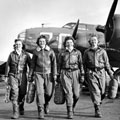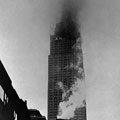Hart Island, an uninhabited strip of land off the Bronx, is America’s largest public cemetery, sometimes known as a “potter’s field.” Since 1869, more than a million people have been buried on Hart Island, including early AIDS patients, unidentified and unclaimed New Yorkers, immigrants, incarcerated people, artists, and about ten percent of New Yorkers who died of COVID-19. Many people buried there are shrouded in anonymity. The island has no headstones or plaques, just numbered markers. Simple pine coffins are stacked in mass graves. In many cases, explanations for how bodies came to be buried there are hard to find.
Our series tells the stories of seven people buried on Hart Island through a range of circumstances. Some were lost in the system after their deaths, while others had been cut off from family and friends for years. One chose Hart Island as his final resting place. Each story is told by the people who knew them best, some of whom overcame tremendous obstacles to uncover what happened to their loved ones.
Drone footage of Hart Island, showing an open grave where Neil Harris Jr. would be buried 3 days later. Hear his story in Episode 1. ©2017 Alon Sicherman courtesy The Hart Island Project. To see an interactive map and explore a database of individuals buried there, go to www.hartisland.net
EPISODE ONE: Neil Harris Jr.
A few years ago, a young man who called himself Stephen became a fixture in Manhattan’s Riverside Park. Locals started noticing him sitting on the same park bench day after day. He said little and asked for nothing. When Stephen’s body was found dead in 2017, the police were unable to identify him, and he was buried on Hart Island. Then, one day, a woman who knew him from the park stumbled upon his true identity, and his backstory came to light. Transcript
EPISODE TWO: Noah Creshevsky
When Noah Creshevsky learned he was dying of bladder cancer two years ago, he decided to decline medical treatment. Soon, he and his husband David were faced with another decision: what would become of his body after he died? Transcript
EPISODE THREE: Angel Garcia
When Annette Vega was seven years old, she found out the man she called “dad” wasn’t her biological father. But all she knew was that her mom had had a teenage romance with a guy named Angel Garcia. Annette has searched for Angel for more than 30 years. That search is coming to the end. Transcript
EPISODE FOUR: Documenting an Invisible Island
For more than a century, it was almost impossible to find out much about people buried on Hart Island. But in 2008, that all changed — thanks in large part to a woman named Melinda Hunt. Melinda is a visual artist who has spent more than 30 years documenting America’s largest public cemetery, and advocating for families with loved ones buried there. Transcript
EPISODE FIVE: Dawn Powell
Dawn Powell wrote novels about people like herself: outsiders who’d come to New York City in the early twentieth century to make a name for themselves. Those novels put her at the center of the city’s literary scene. Ernest Hemingway even called her his “favorite living writer.” After her death, both her books — and her body — disappeared. Transcript
EPISODE SIX: Cesar Irizarry
Angel Irizarry spent years working as a detective, and in 2021 he set out on a personal investigation to track down an uncle who’d been estranged from his family for decades. But early in his search he made a disappointing discovery: his uncle Cesar had died. So Angel embarked on a new quest, to learn what had become of Cesar during his long absence. Reported in collaboration with The City’s Missing Them project. Transcript
EPISODE SEVEN: Hisako Hasegawa
The Belvedere Hotel is in the heart of New York City’s theater district. Many of its guests come to see the sights, take in a show. But there are a few dozen people who call the Belvedere home. Decades ago, they came to New York and rented rooms there. As the hotel changed hands over the years, they never left. One of them was Hisako Hasegawa. Transcript
EPISODE EIGHT: LaMont Dottin
Back in 1995, LaMont Dottin was 21 years old and a freshman at Queens College when, one evening, he didn’t come home. His mother went to the local police precinct to try to report him missing, and his name was added to a list of thousands of cases that the NYPD’s Missing Persons Squad was supposed to be investigating. Then his case fell through the cracks. Transcript.
UPDATE: Hart Island Opens to the Public
After 150 years of being mostly off limits, the New York City Parks Department began hosting its first public tours of Hart Island in November 2023.









